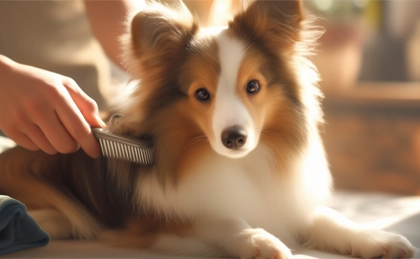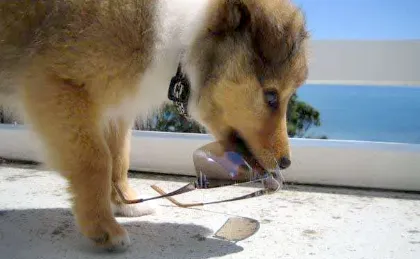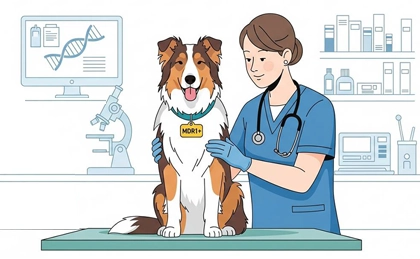Should you neuter your Sheltie? Here are the pros and cons of neutering and why this is an issue no animal lover should ignore.
Neutering your dog means to surgically remove the testicles. It stops your dog from roaming to impregnate females, and reduces the risk of several reproductive diseases. But what are the downsides? Isn't neutering cruel? Let's take a look at the details.

Should you neuter your Shetland Sheepdog?
Should I Neuter My Dog?
It's normal to feel weird about desexing your dog. We don't do it to humans, so how can we justify neutering a beloved canine member of the family?
It's important to recognize these are pets, not people. We often treat dogs as our children, but our dogs will never lead independent lives, get married, and raise their own families. A dog's purpose in life is companionship. In return, we take care of their needs and make the best decisions for them. Desexing is one of those decisions, and there are several factors to consider.
The Pros of Neutering Dogs
1. Prevent overpopulation
According to The Humane Society, three million homeless dogs are euthanized in US shelters every year, many of which are the offspring of family pets. Developing a culture of neutering can save millions of dogs in future, relieving much pain and suffering along the way.
2. Reduce Aggression
On average, intact dogs display more aggression than their neutered counterparts due to their higher levels of testosterone. They're more likely to challenge humans and to fight with other dogs. Neutering is the surgical removal of the testicles, where most testosterone is produced.
3. Reduce Roaming
Intact dogs are highly motivated to roam when they detect females in heat. In this pheromone-driven search, your Sheltie is at serious risk of getting lost, stolen, or hit by a car. Even if you're vigilant about containing your Sheltie, he'll still be aware of all the females in heat within several miles, which will be incredibly frustrating for him. You also need to consider how you will exercise him off the leash in public with this risk.
4. Reduce Testicular Cancer
Neutering completely eliminates the risk of your dog developing testicular cancer. This occurs in 27% of all intact dogs as they get older, the treatment for which is castration and chemotherapy.
5. Reduce Hernias
Up to 93% of perineal hernias occur in older, intact dogs. The colon, bladder, or prostate pokes through the abdominal cavity as a result of testosterone weakening the muscles near the anus. In Shelties, the problem can develop for months before you notice the abnormality under their fur. If untreated, organ damage and restricted blood flow can lead to death.
6. Reduce Tumors
Perianal tumor growth is also stimulated by testosterone, and can be benign or cancerous. They occur much more frequently in older, intact dogs, and require surgery to remove them. Both perianal tumors and hernias are rare in neutered dogs.
7. Save Money
The cost of neutering a dog at a Humane Society or a low-cost clinic is between $35 and $250 depending on the size of your dog and where you live. In the long run, neutering is much cheaper than surgery later in life to treat the tumors, cancers, and hernias seen more often in intact dogs.
The Cons of Neutering Dogs
1. Risk of Anesthesia
Neutering takes place under general anesthesia, which carries risks of developing blood clots, arrhythmia, and respiratory depression while dogs are under. The risk of a dog dying under general anaesthesia is 0.05% and blood work done in advance can reduce the risk further. Herding breeds in particular are more likely to suffer an allergic reaction to pre-anesthetic drugs. This is due to a mutation in the MDR1 mutation in 16% of Shelties which affects the accumulation of certain drugs in the body. Vets should adjust their drug protocol in Shelties to be safe.
2. Risk of CCLR
For decades vets have recommended neutering at 6-9 months, but due to overpopulation, some animal shelters now neuter dogs as young as 6 weeks. Recent studies have linked early neutering to a higher risk of developing Cranial Cruciate Ligament Rupture (CCLR) in large dog breeds due to the lack of testosterone during development. While there is a lack of evidence for this in small breeds, avoid early neutering when possible.
3. Risk of Osteosarcoma
Similarly, large dog breeds neutered before 12 months of age have an increased risk of developing certain cancers, including osteosarcoma, a type of bone cancer. While there isn't enough evidence to paint a full picture for small breeds, delay neutering until close to 12 months.
Final Thoughts
As you can see, there are a few factors to consider before you decide if and when to neuter your Sheltie. The issue that stands out from the crowd is the problem of dog overpopulation. Sadly, there is a lot of ignorance on the subject, so it means a lot when dog owners like yourself take the time to consider the issue.
Note that in the US many professional Shetland Sheepdog breeders require you to sign a neuter agreement before you buy a puppy from them. This is to ensure that only the healthiest and well-adjusted Shelties are bred to propagate the breed standard. Without their care and attention, there would be no Sheltie breed at all.
It also ensures that pet owners don't add to the problem of unplanned breeding and dog overpopulation at large. So if you want a purebred dog as a pet, you will likely be obligated to neuter your Sheltie anyway. This also goes for adopted Shelties: many rescue shelters neuter and spay dogs as a matter of principle before re-homing them.








